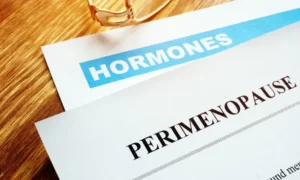Embarking on the journey through perimenopause, women often encounter several changes, and one common aspect that requires thoughtful consideration is perimenopausal bleeding. This natural transition, while significant, can be accompanied by irregularities in menstrual patterns. In this article, we delve into the symptoms, with different treatment options associated with perimenopausal bleeding. Understanding and addressing this phase with informed choices can empower women to navigate through it smoothly, embracing the transformations with resilience and confidence.
Contents
Understanding Perimenopause 
Perimenopause refers to the transitional phase that occurs before menopause. Menopause is the point in a woman’s life when she has not had a menstrual period for 12 consecutive months, marking the end of her reproductive years. Perimenopause typically begins several years before menopause, although the exact duration can vary.
During perimenopause, a woman’s body undergoes hormonal changes, particularly a decrease in the production of estrogen and progesterone by the ovaries. These changes can lead to various symptoms and fluctuations in the menstrual cycle.
The duration of perimenopause varies for each woman, and the symptoms can be different from one individual to another. Perimenopause typically lasts for a few years but can extend for a longer period. It culminates in menopause, which is officially confirmed after 12 consecutive months without a menstrual period.
Symptoms Of Perimenopausal Bleeding
Perimenopausal bleeding can be associated with various symptoms, and it’s essential to pay attention to any changes in menstrual patterns during this transitional phase. Here are common symptoms of perimenopausal bleeding:
- Irregular Menstrual Cycles
- One of the hallmark symptoms is irregularity in the menstrual cycle. Women may experience variations in the length of their menstrual cycles and changes in the amount of menstrual flow.
- Heavy Menstrual Bleeding
- Perimenopausal women may notice episodes of unusually heavy menstrual bleeding, leading to the need for more frequent changes in sanitary products.
- Prolonged Menstrual Periods
- Menstrual periods may become longer than usual during perimenopause. Women may find that their periods last for an extended duration.
- Spotting Between Periods
- Spotting or light bleeding between regular menstrual periods can occur. This can be a sign of hormonal fluctuations during perimenopause.
- Changes in Menstrual Flow
- Women may experience changes in the type of menstrual flow, such as the presence of clots or a different consistency of blood.
- Vaginal Dryness
- Perimenopause is associated with a decline in estrogen levels, which can lead to changes in the vaginal tissues. Vaginal dryness may contribute to discomfort or pain during intercourse.
- Mood Swings
- Hormonal fluctuations during perimenopause can impact mood. Some women may experience mood swings, irritability, or emotional changes.
- Hot Flashes and Night Sweats
- While perimenopausal bleeding is primarily related to changes in menstrual patterns, women may also experience common menopausal symptoms like hot flashes and night sweats.
- Sleep Disturbances
- Changes in hormone levels can affect sleep patterns. Some women may experience difficulty falling asleep or staying asleep during perimenopause.
- Fatigue
- The combination of hormonal changes and disrupted sleep patterns may contribute to feelings of fatigue and decreased energy levels.
Treatment Options For Perimenopausal Bleeding 
The treatment of perimenopausal bleeding depends on the underlying cause, the severity of symptoms, and the woman’s overall health. It’s important to consult with a healthcare professional to determine the most appropriate course of action. Here are various treatment options for perimenopausal bleeding:
Hormone Replacement Therapy (HRT)
HRT involves the use of estrogen and, in some cases, progestin to balance hormonal levels. This can regulate menstrual cycles and alleviate symptoms of perimenopausal bleeding. However, HRT is not suitable for everyone, and its use must be carefully considered, as it may have associated risks.
Nonsteroidal Anti-Inflammatory Drugs (NSAIDs)
NSAIDs, such as ibuprofen, can be used to reduce menstrual bleeding and relieve associated pain. While not a direct treatment for perimenopausal bleeding, NSAIDs can be helpful in managing symptoms.
Tranexamic Acid
Tranexamic acid is a medication that helps reduce heavy menstrual bleeding by preventing blood clots from breaking down. It can be prescribed to women experiencing significant bleeding during perimenopause.
Oral Contraceptives
Birth control pills containing both estrogen and progestin can help regulate menstrual cycles and reduce the intensity and duration of perimenopausal bleeding. They are often prescribed for women who do not have contraindications to hormonal contraceptives.
Intrauterine Devices (IUDs)
Progestin-releasing intrauterine devices, such as the levonorgestrel IUD, can be effective in reducing heavy menstrual bleeding. They work locally in the uterus and can provide long-term contraception.
Endometrial Ablation
Endometrial ablation is a procedure that destroys the lining of the uterus. It is considered for women with heavy bleeding who do not wish to have more children. It is not a suitable option for those with certain uterine abnormalities.
Dilation and Curettage (D&C)
D&C is a surgical procedure in which the lining of the uterus is scraped away. It is not a first-line treatment but may be used for diagnostic purposes or to manage persistent bleeding.
Surgery (Hysterectomy)
In cases of severe or recurrent perimenopausal bleeding that does not respond to other treatments, a hysterectomy (removal of the uterus) may be considered. This is a major surgical procedure and is usually reserved for cases where other interventions have not been successful or are not appropriate.
Lifestyle and Dietary Changes
Adopting a healthy lifestyle, including regular exercise, a balanced diet, and stress management, can have a positive impact on perimenopausal symptoms, including menstrual irregularities.
It’s crucial for women experiencing perimenopausal bleeding to consult with a healthcare provider for a thorough evaluation and to discuss the most suitable treatment options based on individual health factors and preferences. Additionally, regular follow-up appointments are important to monitor the effectiveness of the chosen treatment and make any necessary adjustments.
Alternative Therapies To Manage Perimenopausal Bleeding 
Several alternative therapies may offer relief for some women experiencing perimenopausal bleeding. It’s important to note that the effectiveness of these approaches can vary, and individual responses may differ. Before starting any alternative therapy, it’s advisable to consult with a healthcare professional to ensure safety and suitability. Here are some alternative therapies that women may consider:
- Herbal Supplements
Certain herbs are believed to have potential benefits in managing perimenopausal symptoms, including bleeding. Examples include:- Chaste tree (Vitex agnus-castus): Thought to help balance hormones.
- Black cohosh: Suggested to alleviate menopausal symptoms, including irregular bleeding.
- Dong Quai (Angelica sinensis): Used in traditional Chinese medicine to address menstrual irregularities.
- Dietary Supplements
Some women find relief from perimenopausal symptoms by taking dietary supplements. Examples include:- Omega-3 fatty acids: Found in fish oil, these may help reduce inflammation and alleviate symptoms.
- Calcium and Vitamin D: Important for bone health during menopause.
- Magnesium: This may help with muscle relaxation and stress management.
- Acupuncture
Acupuncture, an ancient Chinese practice involving the insertion of thin needles into specific points on the body, is believed by some to help balance energy and alleviate menopausal symptoms, including irregular bleeding. - Yoga and Meditation
Mind-body practices, such as yoga and meditation, can help manage stress and promote overall well-being. Stress reduction may have a positive impact on perimenopausal symptoms. - Biofeedback
Biofeedback techniques involve learning how to control physiological functions, such as heart rate and muscle tension, to reduce stress and potentially improve symptoms associated with perimenopausal bleeding. - Homeopathy
Homeopathic remedies are based on the principle of “like cures like.” Some women report benefits from homeopathic treatments tailored to their specific symptoms. Consultation with a qualified homeopath is recommended.
Conclusion
In conclusion, perimenopausal bleeding is a common but manageable aspect of a woman’s life. Seeking medical advice, exploring treatment options, and embracing lifestyle changes can contribute to a smoother journey through this transitional phase.
If you are facing menopause-related issues, menopause treatment at HerMantra can help. Book your free trial online menopause treatment session now.





